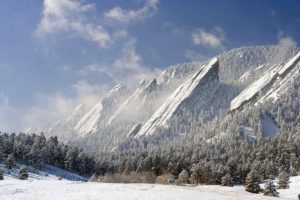Winter Storm
 Winter storms vary in size and strength and can be accompanied by strong winds that create blizzard conditions and dangerous wind chill. There are three categories of severe winter storms:
Winter storms vary in size and strength and can be accompanied by strong winds that create blizzard conditions and dangerous wind chill. There are three categories of severe winter storms:
- Blizzard – is the most dangerous of all winter storms. It combines low temperatures, heavy snowfall, and winds of at least 35 miles per hour, reducing visibility to only a few yards.
- Heavy Snowstorm – is one that drops 4 or more inches of snow in a 12-hour period.
- Ice storm – occurs when moisture falls and freezes immediately upon impact.
Before the storm:
- Be familiar with winter storm watch and warning messages. Service snow removal equipment and have rock salt on hand to melt ice on walkways and sand or kitty litter to generate temporary traction.
- To keep pipes from freezing, wrap them in insulation or layers of newspaper, and then cover with plastic to keep out moisture.
- Insulate walls and attic.
- Caulk and weather-strip doors and windows.
- Install storm windows or cover windows with plastic from the inside.
- Locate water valves and know how to shut them off, if necessary.
During the storm:
Indoors:
- Stay inside.
- If you are using alternative heat, follow fire safety guideline and ensure proper ventilation.
- Close off any unused rooms.
- Put towels at the base of doors.
- Eat nutritious foods and drink plenty of fluids to provide energy and stay hydrated.
Outdoors:
- Find shelter. If none is available, build a lean-to, windbreak or snow cave for protection from the wind.
- Build a fire for heat and to attract attention. Place rocks around the fire to absorb and reflect heat.
- Eating snow for hydration will cause your body temperature to drop; melt it first.
- If you are stuck in your car, run the motor for 10 minutes each hour for heat. Make sure that your tailpipe is clear of snow.
- Make yourself visible to rescuers by turning on the dome light at night when running the engine, or by tying a brightly colored cloth to your antenna.
- Exercise periodically by energetically moving legs, arms fingers and toes to increase circulation and body temperature.
After the storm:
- Assist neighbors who may need assistance, such as the elderly, people with infants, or those with access and functional needs.
- Remove ice and snow from tree limbs, roof and other structures after the storm passes.
- When shoveling snow, avoid overexertion. Colder temperatures add strain to the heart, and can make strenuous activity feel less tiring. Be attentive to signs of dehydration.
- When outdoors, wear layers of warm, loose-fitting, lightweight clothing. Layers can be removed to prevent chill. Cover your mouth to protect your lungs from extremely cold air and avoid speaking unnecessarily.
- Watch for signs of frostbite, such as loss of feeling and a pale appearance in fingers, toes, nose and earlobes. If these signs are present, seek immediate medical attention.
- Watch for signs of hypothermia, including uncontrollable shivering, slow or slurred speech, exhaustion and stumbling. If these are detected, get to a warm location, remove wet clothing and drink warm, non-alcoholic beverages. Get medical attention as soon as possible.
Winter driving:
- Winterize your car, including a battery check, antifreeze, oil level and tires. Check thermostat, ignition system, lights, hazard lights, exhaust system, heater, defroster and brakes. Snow tires are recommended, and chains may be required in certain conditions, especially in the mountains.
- Always keep your gas tank at least half full.
